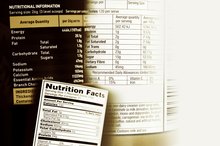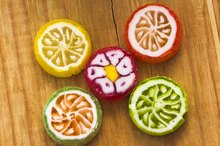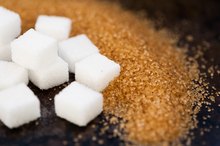What does fact checked mean?
At Healthfully, we strive to deliver objective content that is accurate and up-to-date. Our team periodically reviews articles in order to ensure content quality. The sources cited below consist of evidence from peer-reviewed journals, prominent medical organizations, academic associations, and government data.
The information contained on this site is for informational purposes only, and should not be used as a substitute for the advice of a professional health care provider. Please check with the appropriate physician regarding health questions and concerns. Although we strive to deliver accurate and up-to-date information, no guarantee to that effect is made.
How Can a Food Label Say Sugar Free & Contain High Fructose Corn Syrup?
High fructose corn syrup is a sweetener commonly found in products such as jelly, beverages and commercially baked goods. The U.S. Food and Drug Administration advises consumers who are concerned about sugar intake to check ingredient labels for added sugars by other names, such as high fructose corn syrup 2. Products labeled sugar-free are not necessarily free of high fructose corn syrup.
Identification
High fructose corn syrup is manufactured from corn starch in a process that converts dextrose to fructose 2. The sweetener typically contains either 42 or 55 percent fructose, according to the FDA. To convert 42 percent fructose corn syrup to 55 percent fructose, manufactures employ a process that concentrates the fructose portion, explains the FDA.
- High fructose corn syrup is manufactured from corn starch in a process that converts dextrose to fructose 2.
- To convert 42 percent fructose corn syrup to 55 percent fructose, manufactures employ a process that concentrates the fructose portion, explains the FDA.
Considerations
Canderel Side Effects
Learn More
Products bearing the claim "sugar-free" on the label must meet certain criteria as established by the FDA. To qualify for the claim, a product must contain less than 0.5g of sugar per labeled serving. Although the FDA mandates that a product making this claim should be free of added sugar or any ingredient known to contain sugar, the organization does allow room for exceptions.
Exceptions
MayoClinic.com reports that high fructose corn syrup is the most frequently used sweetener in processed foods and drinks 2. A product containing high fructose corn syrup or other added sugars can make the "sugar-free" claim if specific criteria are met 2. If a product contains less than 0.5g of sugar but contains added sugar, the sweetener must be disclosed in the ingredient list.
Disclosure
Saccharin Safety in Toothpaste
Learn More
Sweeteners in the ingredient list of products making "sugar-free" claims must be followed by an asterisk. In the notes under the ingredient list, the FDA requires that the label include one of the following statements: "adds a trivial amount of sugar," "adds a negligible amount of sugar" or "adds a dietary insignificant amount of sugar." The product must also be a low-calorie or reduced-calorie food or disclose that it is "not a reduced-calorie food" or "not for weight-control" on the label.
Effects
High fructose corn syrup, like other types of added sugars, can have a negative effect on your health 2. Too much sugar potentially leads to weight gain, inadequate nutrition and cavities, according to MayoClinic.com. Sweeteners such as high fructose corn syrup can also increase triglyceride levels. To limit high fructose corn syrup in your diet, cut back on processed foods and choose naturally sweetened foods, such as fruit, more often.
- High fructose corn syrup, like other types of added sugars, can have a negative effect on your health 2.
Related Articles
References
- FDA: Direct Food Substances Affirmed as Generally Recognized as Safe: High Fructose Corn Syrup
- MayoClinic.com: High Fructose Corn Syrup: What Are the Health Concerns?
- FDA: Code of Federal Regulations Title 21
- Popkin BM, Hawkes C. Sweetening of the global diet, particularly beverages: patterns, trends, and policy responses. Lancet Diabetes Endocrinol. 2015;4(2):174-186. doi:10.1016/S2213-8587(15)00419-2
- New Hampshire Department of Health and Human Services. How much sugar do you eat?. Updated August 2014.
- DeSilver D. How America's diet has changed over time. Pew Research Center. Updated December 13, 2016.
- Lakhan SE, Kirchgessner A. The emerging role of dietary fructose in obesity and cognitive decline. Nutr J. 2013;12:114. doi:10.1186/1475-2891-12-114
- Djiogue S, Nwabo Kamdje AH, Vecchio L, et al. Insulin resistance and cancer: the role of insulin and IGFs. Endocr Relat Cancer. 2013;20(1):R1-R17. doi:10.1530/ERC-12-0324
- Page KA, Chan O, Arora J, et al. Effects of fructose vs glucose on regional cerebral blood flow in brain regions involved with appetite and reward pathways. JAMA. 2013;309(1):63-70. doi:10.1001/jama.2012.116975
- Goran MI, Ulijaszek SJ, Ventura EE. High fructose corn syrup and diabetes prevalence: a global perspective. Glob Public Health. 2013;8(1):55-64. doi:10.1080/17441692.2012.736257
- Walker RW, Dumke KA, Goran MI. Fructose content in popular beverages made with and without high-fructose corn syrup. Nutrition. 2014;30(7-8):928-35. doi:10.1016/j.nut.2014.04.003
- American Heart Association. Added sugars. Updated April 17, 2018.
Resources
Writer Bio
Pam Murphy is a writer specializing in fitness, childcare and business-related topics. She is a member of the National Association for Family Child Care and contributes to various websites. Murphy is a licensed childcare professional and holds a Bachelor of Arts in English from the University of West Georgia.









